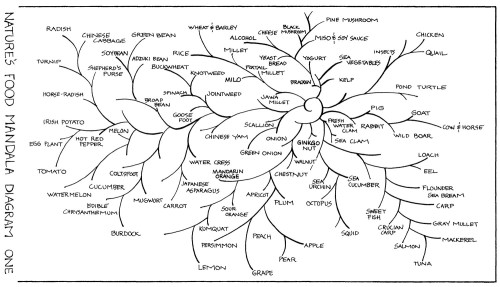Buddhist - Tumblr Posts

Buddhist Rain Chain

The Four Nisrayas - earring pair 1

The Four Nisrayas - earring pair 2

The Four Nisrayas - earring pair 3

The Four Nisrayas - earring pair 4

The Four Nisrayas - earring pair 5

The Four Nisrayas - necklace 1

The Four Nisrayas - necklace 2


It took some time, after finishing the "One Straw Revolution" (by. Masanobu Fukuoka) to find his food mandalas. His "do nothing" philosophy is very appealing in a lot of ways. He sought harmony with nature in his daily away from capitalism, and I believe he lived his teachings till the end of his days. Although, I currently don't own land for farming. I want to apply his teachings: mindfulness, and being keen to listen to silence. Sometimes doing nothing and allowing nature to balance itself.
I may read this book again as I continue to grow.
When the Buddha said all life is suffering, he wasn't joking, huh?


How much of a person can you change before they're no longer the same person? How much of you could hypothetically be different before you're no longer you?
If you had been born into a different financial situation, a different family, different ethnicity, different country, how much of you could you really recognise? Even if you were genetically identical to as you are now, if you experienced an even slightly different upbringing, how similar could you argue that you'd really be? How different can you be while still being "you"?
As people, we are the product of both nature and nurture. Our genes and our environment. We take our memories and our bodies and our personality as proof of an "I", when really this "I" that has formed is a result of things playing out just as they have up to this very moment in one long chain of cause and effect. If there are parallel universes, how would the "you" there be you at all? If their genes or upbringing was even slightly different, perhaps by even one event, they wouldn't be the same as you anymore would they?
And if this is the case, what sort of unchanging, permanent you could there be at all? As even minutely different subjective experience can cause people to differ so greatly, what remains?
Only that which has experienced.
How much of a person can you change before they're no longer the same person? How much of you could hypothetically be different before you're no longer you?
If you had been born into a different financial situation, a different family, different ethnicity, different country, how much of you could you really recognise? Even if you were genetically identical to as you are now, if you experienced an even slightly different upbringing, how similar could you argue that you'd really be? How different can you be while still being "you"?
As people, we are the product of both nature and nurture. Our genes and our environment. We take our memories and our bodies and our personality as proof of an "I", when really this "I" that has formed is a result of things playing out just as they have up to this very moment in one long chain of cause and effect. If there are parallel universes, how would the "you" there be you at all? If their genes or upbringing was even slightly different, perhaps by even one event, they wouldn't be the same as you anymore would they?
And if this is the case, what sort of unchanging, permanent you could there be at all? As even minutely different subjective experience can cause people to differ so greatly, what remains?
Only that which has experienced.
Iconographic Buddha
How teachings, traditions, and invasions led to transition in Buddhist art

Before the invasion of Alexander the Great, and the coming of the Greco-Buddhist era, Buddhist artwork didn't actually feature the Buddha. The earliest Buddhist artwork, from before the 1st century of the common era, used a style of divine art called acinonism. Acinonism is art which doesn't show material beings or human forms, but rather symbols. For instance, the Buddha may be pictured through an empty throne or a dharma wheel.
However, as mentioned, when Alexander the Great invaded the East, a new era arrived; the Hellenistic East. Greeks travelled to Asia to learn of Buddhist cultures, and Buddhist monks were also known to travel to Greece for similar reasons. This cultural exchange led to many things, but one in particular was the personification of the Buddha.
In the acinonical age, art found in places such as Amaravati told the story of the Buddha through symbols. His mother, Maya, dreamt of an elephant entering her womb before he was born, and this event was recorded in art as a divine elephant. The birth of the Buddha was depicted as a lotus, which is a profound and sacred Buddhist symbol, and could also relate to the story of lotuses cushioning his feet as the Buddha walked to his mother after birth.
The interesting thing is that this art didn't lack human forms. The Buddha's mother, his friends, worshippers, brahma Gods and more were all seen in human form. Is there a reason why the Buddha was never pictured until later centuries? Was it prohibited?
Yes and no, is the answer, because different teachings say different things, but the most popular canon is taken from the Kāliṅga-Bodhi-Jātaka. The Buddha is asked if relics can be made of him when he is away from the temple, for followers to give their offerings to. One of the three relics is of the body - of his visage - and, at the time, the Buddha rejected this, as this was for Buddhas who had reached parinibbāna: the state of nirvana that came after death.
Now, if you look at the dates of when the Buddha was thought to move on from this life, and when Alexander the Great began his invasion of Asia, we can begin to understand why the Greeks (who were fans of anthromorphic iconography) invading marked the beginning of Buddha statues as we know. Alexander the Great began invading Asia in 334 BCE. The Buddha was thought to pass on from this life somewhere around 400 BCE.
Now, here's the extra fun part. The thing is, while we can make reference to acinonism in early Buddhism before the Buddha had left this earth, and we can make reference to how the Greco-Buddhist era introduced iconographing the Buddha, these things are debated between scholars! As you'll read in one of the sources below, if you choose to, one writer even added a whole appendix to their work explaining aconical Buddhist art, saying that the term is not even applicable to the subject because of the clear canon by which the Buddha states his visage may be used after parinibbāna, and as history tells us, it was.
The exact origin of Buddha statues is even debated. While it's generally accepted that the Greco-Buddhist era played it's part in the cultivation of such art (as the Greeks were big on iconography, and brought this with them), there are a few locations credited to the origins of these new artistic creations, namely Gandhara and Mathura, in modern day Pakistan and India, respectively.
All in all, the history of the transition from non-human icons, like the lotus and the wheel, may be debated from source to source, but when we look closely at the teachings and theories, each holds it's truth. The Buddha did not want his visage used as a relic while alive because he did not believe that worship and learning should take place in the imagination. However, he saw the need for it once he had moved on. It just so happens that, within a century of his death, the Greeks were making their way through Asia. With a love for iconography, and ambivalence towards Buddhism, they may indeed have influenced the cultivation of such art as it began being created for the first time.
Sources:
The Buddha Image: Its Origin and Development by Yuvraj Krishan, Kalpana K. Tadikonda [ via books.google.co.uk ]
The Lotus Symbol: Its Meaning in Buddhist Art and Philosophy by William E. Ward [ via jstor.org ]
Early Buddhist Art and the Theory of Acinonism by S. L. Huntington [via encyclopediaofbuddhism.org ]
When the Greeks Converted the Buddha: Asymmetrical Transfers of Knowledge in Indo-Greek Cultures by Georgios T. Halkias [ via brill.com ]
Elements of Buddhist Iconography by Ananda Kentish Coomaraswamy [ via turiya.vidya.hu ]
Greco-Buddhist Art by Unknown [ via hellinicaworld.com ]
Wat Tha Ton temple in Chiang Mai Province, Thailand

The mind is everything. What you think you become.
Buddha


